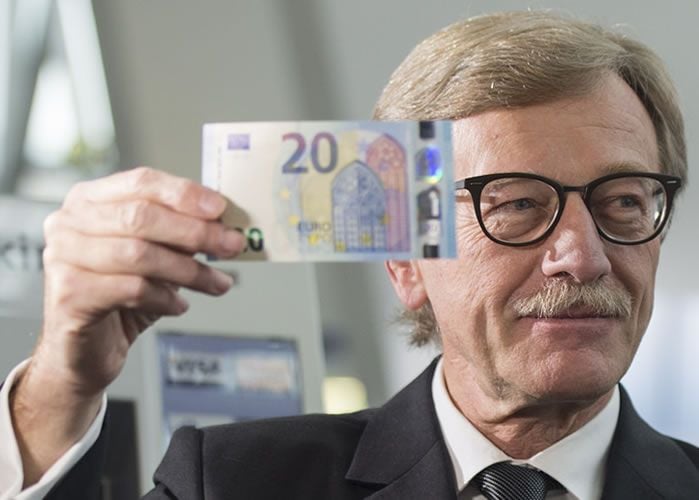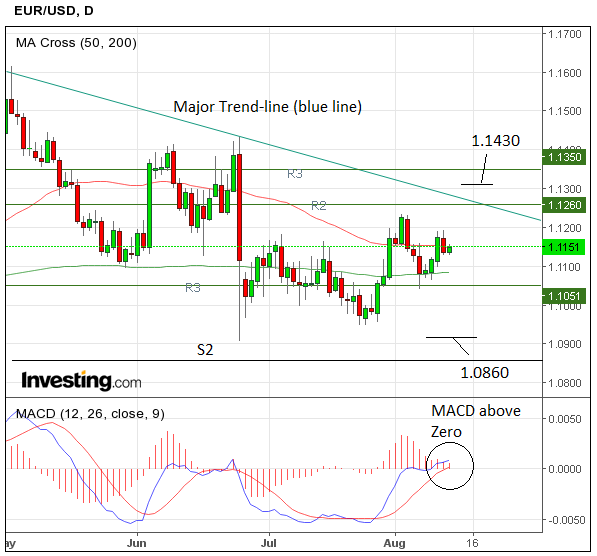EUR/USD Rate Breaks 1.12 but is Fast Approaching Key Trendline Resistance
Further rises in the EUR/USD pair should see the pair encounter resistance from a major trend-line; a break above it would usher in a more bullish scenario for the pair.

The EUR/USD exchange rate is half a percent higher at the time of writing with the pair smashing through the 1.12 level.
This is a notable move as 1.12 is seen as a strong point of resistance that thwarted the Euro bulls when they last attempted a rally in early August.
The subsequent failure of that botched move higher saw a period of consolidation below 1.12 and above 1.11.
However, there appears to be fresh intent to carry EUR/USD higher as the US Dollar continues to suffer.
We would however expect questions to be asked of the Euro's strength before long having noted the longer-term timeframes point to further weakness.
The EUR/USD is seen closing in on a major trend-line drawn from 2014, which is situated at about 1.1300:
Commerzbank's Karen Jones expects that if the rate meets the trend-line it will be rejected and probably move back down within the range.
However, if the rate is capable of breaking above, confirmed by a move above 1.1330, then the chart will take on a much more bullish perspective, with a move up to 1.1430 initially expected and then possibly, all the way up to 1.1700.
Scotiabank’s market strategist Shaun Osborne, however, sees more upside for the euro, but USD weakness as being “limited”, which seems to support the view that EUR/USD will rise a little higher to the two-year old trend-line and then be repulsed back down by it.
Alternatively a breakdown below the 1.0909 lows would probably lead to a move down to support at 1.0860.
Morgan Stanley Backing Further Euro Strength
Expect the EUR to stay supported argue Morgan Stanley in their latest brief to clients on the currency's likely direction.
Behind the expected strength Morgan Stanley cite and interesting, if somewhat counter-intuitive argument.
The results from a German ZEW study which showed that EU banks have larger capital shortfalls than that indicated by the official EBA stress test, supporting analyst arguments that the Eurozone's financial institutions are unable to export long-term capital due to their weak balance sheets.
"This results in the commercial demand for EUR from the Eurozone's rising current account surplus dominating, helping the EUR stay supported," says Rubenfeld.
EURUSD has been relatively stable in the past week despite USD weakness, and Morgan Stanley forecast the pair to catch up with USD weakness.
"As such, we like buying EUR against USD and particularly against GBP," says Rubenfeld.
All Eyes on US Inflation Data
Inflation data for July, which is forecast to show a 0.2% rise mom and 0.9% (from a previous 1.0%) year-on-year.
"Lower than expected US CPI today would further add to the recent soft USD environment and underpin the EM FX rally of late, high yielding FX in particular," notes Petr Krpata at ING.
Markets are forecasting CPI to read at 0.2%, anything below here will likely prompt a fresh bout of USD weakness which would allow EUR/USD to travel closer towards that trend line resistance we have mentioned.
Real Average Weekly Earnings in July (yoy) are also in the calendar for Tuesday and are likely to be closely watched for their potential impact on the Federal Reserve’s anticipated policy trajectory.
On Wednesday the Fed meeting minutes will be released.
Clearly the minutes will be scoured for potential insights into then the next rate hike could be - although this often overly hyped release often ends in no discernible change in the outlook as it rarely contains new information.
The week ends with the Philadelphia Fed Manufacturing Index on Thursday August 18, which is forecast to rise to 1.5 from -2.9 previously.
Data for the Euro in the coming week
The first big release for the Euro will be the ZEW sentiment survey, on Tuesday which is expected to show a positive balance of 1.0, denoting investment professionals are marginally positive about the outlook for the next six months.
The second major release from Europe is inflation data on Thursday which is expected to show a 0.2% rise yoy in July as in the previous year.
Clearly inflation will be an invaluable metric to gain guidance on what the ECB may be planning to do in September.
The central bank had said immediately after the Uk referendum that it stood ready to increase stimulus to soften the blow, however, Draghi somewhat backtracked from that position at the August meeting after it was noted the impact on the Eurozone had been somewhat muted.
Nevertheless, many analysts, such as Lloyds Commercial Banking’s Jaevon Lolay, expect the ECB to increase its measures in September anyway, and for this to weigh on the euro. If inflation on Thursday, however, is higher-than-expected, that expectation, will diminish, leading to rise in the euro, as stimulus weakens a currency and vis versa











